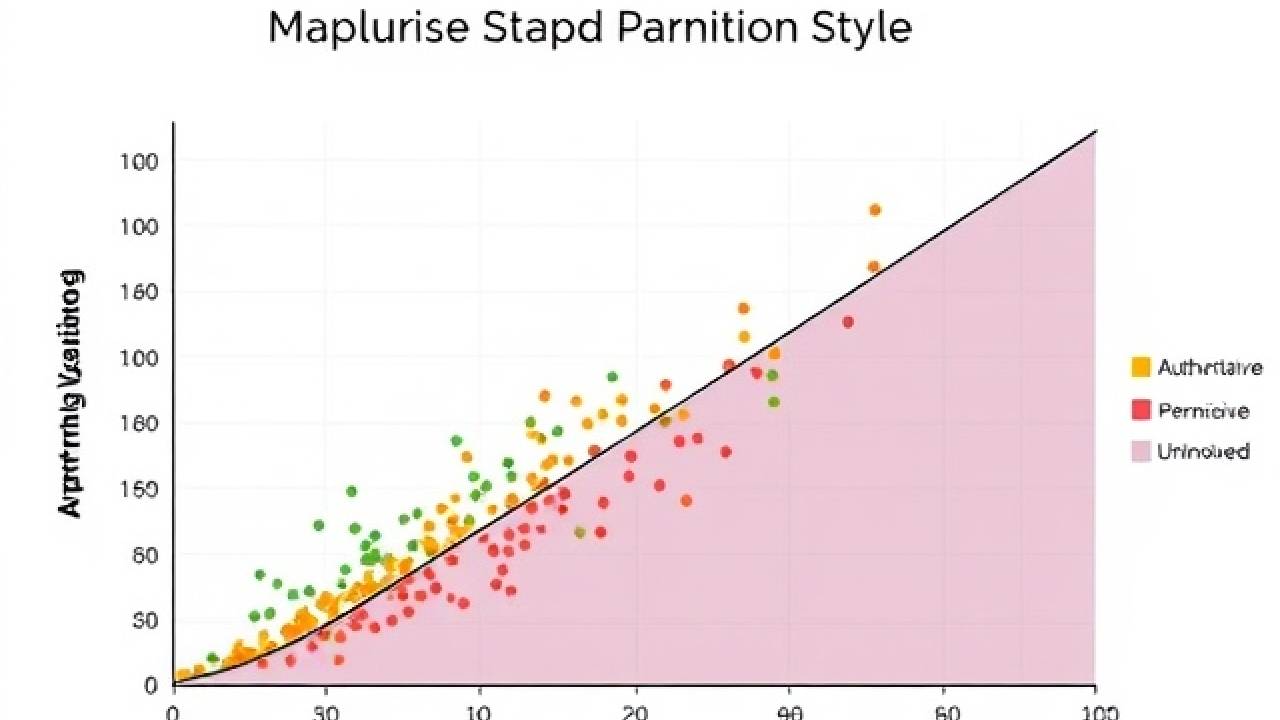As the fabric of family dynamics continues to evolve, the need for insightful metrics has never been greater. A Parenting Style Repartition Graph does more than present dry statistical data; it reveals patterns and tendencies that help experts decode complex familial interactions. Such tools are invaluable for both researchers assessing societal trends and psychologists dealing with individual family units.
The origins of utilizing Parenting Style Repartition Graph can be traced back to the mid-20th century, during the pioneering studies of developmental psychology. Nowadays, recent data shows that authoritative parenting, characterized by high responsiveness and high demands, is adopted by approximately 58% of surveyed parents in various countries. This method of graphical representation not only helps in understanding widespread parenting behaviors but also assists in developing targeted interventions that support healthier parent-child relationships.
A parenting style repartition graph is a visual tool used to analyze and display the distribution of different parenting styles within a specific population. This graph helps experts identify prevalent parenting behaviors and their impacts, guiding interventions and educational content to promote effective parental practices.
Parenting Style Repartition Graph: Unraveling its Meaning
A Parenting Style Repartition Graph might sound complicated, but it’s actually a useful tool. It helps us see how different parenting styles are distributed across various populations. By looking at these graphs, experts can gather insights on which styles are most common and how they affect children’s development.
This type of graph usually showcases the four main parenting styles: authoritative, authoritarian, permissive, and uninvolved. Each style has unique characteristics and impacts on children. For example, authoritative parents are both responsive and demanding, which research shows can lead to well-rounded children.
But why use a Parenting Style Repartition Graph? Visuals like these make complex data easier to understand. They help people quickly grasp significant patterns in parenting practices around the world. Such graphs often feature colors or symbols to differentiate between the styles, making the data not only informative but also visually appealing.
Studying these graphs reveals more than just numbers. They help educators and parents understand which styles are prevalent in different regions or communities. This understanding can guide better parenting programs and educational campaigns, aiming to promote healthy upbringing strategies across different cultural backgrounds.
Implications of Parenting Style Repartition in Studies
Researching Parenting Style Repartition Graph isn’t just about identifying which ones are common. These studies also examine how each style impacts children’s behavior and academic success. For instance, children raised by authoritative parents tend to perform better in school and have better social skills. Understanding these outcomes helps experts recommend best practices for raising children.
Studies on Parenting Style Repartition Graph provide valuable data, helping policymakers and educators develop targeted programs. For example, areas with higher concentrations of authoritarian parenting might receive programs encouraging more engagement and warmth between parents and children. This proactive approach supports healthier community relationships.
The implications reach global health initiatives as well. By analyzing different parenting styles and their outcomes, researchers can address broader issues like mental health and educational disparities. Such data fuels international efforts to craft campaigns that promote positive parenting techniques worldwide, aiming to boost overall child development.
Finally, parenting style research often sparks dialogue across cultures about what methods are most beneficial. These discussions can lead to a cross-cultural exchange of ideas, enriching parenting practices around the world. Studies not only highlight differences but also foster a sense of global community in the pursuit of raising well-rounded individuals.
The psychology behind Different Parenting Styles
Different parenting styles can shape the way children grow up, influencing everything from their self-esteem to their problem-solving skills. Psychologists have identified key styles including authoritative, authoritarian, permissive, and uninvolved. Each style represents a unique approach to parenting, with varying degrees of warmth, discipline, and communication.
The authoritative style is often considered the most effective. This style combines high expectations with high responsiveness, creating a supportive environment for children. Kids raised by authoritative parents usually exhibit good social skills and high self-confidence, which are crucial for successful personal development.
On the other hand, authoritarian parents are strict and expect obedience without question. This style can lead to children who are good at following rules but may lack spontaneity and may struggle with self-esteem. Their emotional understanding and problem-solving skills can sometimes be less developed due to limited opportunities for open dialogue.
Permissive parents, who are lax and rarely enforce rules, foster a different set of traits. Their children might develop great creativity and freedom of thought but could struggle with self-discipline and organization. Understanding these psychological impacts helps parents, educators, and counselors support each child’s needs more effectively.
Using Graphs to Analyze Parenting Styles: A Breakdown
Graphs are powerful tools that help us visualize complex data easily, and they are especially useful in the study of parenting styles. By plotting different styles on a graph, researchers can quickly identify trends and patterns that might be hard to see in raw data. This visualization aids in understanding how prevalent each parenting style is within a certain population.
Typically, these graphs categorize parenting into four main styles: authoritative, authoritarian, permissive, and uninvolved. Each style is plotted based on how commonly it occurs within a study’s demographic. This helps educators and psychologists tailor their approaches to fit the needs of specific communities or groups.
The data for these graphs often come from surveys where parents answer questions about their parenting tactics and attitudes. The answers are then used to classify their style according to established psychological criteria. This method ensures that the graphs provide a reliable snapshot of parenting behaviors.
Graphs not only show the current state of parenting styles but also track changes over time. Researchers can compare current data with past data to see if parenting trends are shifting. This can be particularly insightful when considering the impacts of societal changes, like digital technology use or shifts in educational policies.
Here’s how different parenting styles might appear on a graph:
- Authoritative: High both in demands and responsiveness.
- Authoritarian: High in demands but low in responsiveness.
- Permissive: Low in demands but high in responsiveness.
- Uninvolved: Low in both demands and responsiveness.
By studying these graphs, professionals can better understand the dynamics within families and develop more effective interventions to support healthy child development. Effective use of graphs can make the intricate data of parenting styles both accessible and actionable for anyone interested in the well-being of children.
Influence of Cultural and Societal Factors on Parenting Styles
Parenting is deeply influenced by the cultural and societal context in which it occurs. Different cultures can have very different norms and values, which in turn affect how parents raise their children. For instance, collectivist societies like those in many Asian countries may favor authoritarian and involved parenting styles that emphasize respect for authority and family cohesion.
In contrast, individualistic societies such as the United States and Western Europe often encourage a more permissive or authoritative approach. These parenting styles foster independence and self-expression, values that are highly regarded in these cultures. This demonstrates how societal priorities shape parenting techniques and objectives.
Economic factors also play a significant role in shaping parenting styles. Families in wealthier environments might have access to more resources and education about child-rearing, which can promote more responsive and nurturing parenting styles. On the other hand, economic pressures can also lead to stressed parenting behaviors, which might be less consistent and more authoritarian.
Media influence cannot be overlooked either. Television, movies, social media, and books can all shape parental expectations and norms. Parents might adopt styles they see portrayed as ideal or successful in media, or reject those depicted negatively. This mimicking can happen subconsciously and across different societal layers.
- Collectivist societies: Emphasize family cohesion and respect for authority
- Individualistic societies: Value independence and self-expression
- Economic stability: Allows for more nurturing and responsive parenting
- Economic stress: May lead to more authoritarian parenting practices
By understanding these cultural and societal influences, parents, educators, and policymakers can work together to support parenting practices that are both culturally sensitive and beneficial to children’s development. This understanding helps establish more effective and empathetic educational and support systems for families from diverse backgrounds.
Reflecting on Parenting Style Repartition Insights
Understanding the diversity of Parenting Style Repartition Graph not only enriches our comprehension of family dynamics but also enhances the targeted support systems for parents and children. This analytical tool bridges the gap between research data and practical application in various cultural contexts.
By leveraging these insights, experts can cultivate strategies and programs that address specific needs, ultimately fostering environments that support optimal child development and parental satisfaction. These informed interventions are crucial in shaping a well-adjusted next generation.
FAQ:
What is Parenting Style Repartition Graph?
A Parenting Style Repartition Graph is a visual tool used to analyze and display the distribution of different parenting styles within a specific population.
What does the Parenting Style Repartition Graph primarily offers?
Parenting Style Repartition Graph provide valuable data, helping policymakers and educators develop targeted programs.
What are the main parenting styles represented in a Parenting Style Repartition Graph?
The four main parenting styles typically represented in Parenting Style Repartition Graph, are- authoritative, authoritarian, permissive, and uninvolved.







